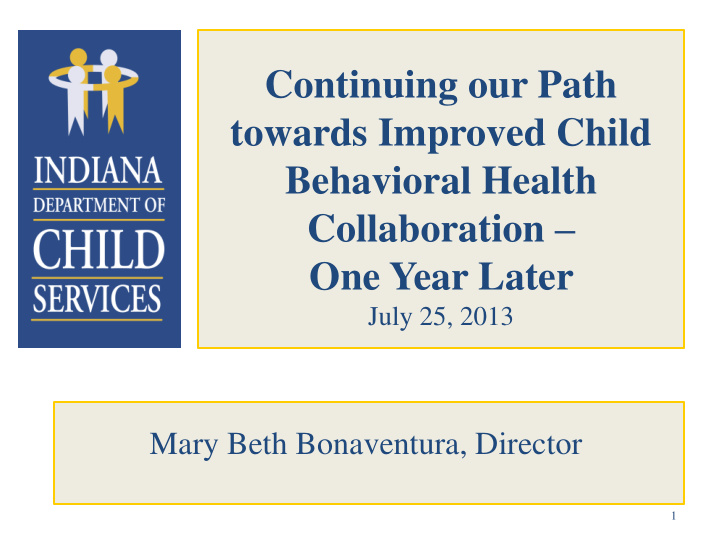



Continuing our Path towards Improved Child Behavioral Health Collaboration – One Year Later July 25, 2013 Mary Beth Bonaventura, Director 1
Goals of the Partnership • Ensure Indiana families and children are connected to the most appropriate and most effective services to meet their needs both short term and long term. • Maximize utilization of Medicaid reimbursement for behavioral health services. 2
The Partnership • Established 3 years ago • Improved relationships and service coordination • Beginning to establish a shared language • We still have work to do! 3
Number of Community based and MRO service referrals made by DCS staff in SFY 2013 Type of provider Number of referrals Percentage of total referrals Community Mental Health 38,115 33.58% Providers Non- CMHC 75,391 66.42% 113,506 • CMHCs make up 10% of the DCS providers and received a third of DCS referrals.
Trauma Informed Care 5
The Practice Model • The blueprint Indiana used to build the Department. • Teaming, Engaging, Assessing, Planning, and Intervening. • Safely Home, Families First- A reaffirming of the effort to keep children at home, or with relatives when they can’t safely remain at home. 6
Trauma-Informed Care Background: • Trauma refers to events that overwhelm a child’s capacity to cope and elicit feelings of terror, powerlessness, and out-of-control physiological arousal. • Most children entering the child welfare system have experienced significant trauma.* *National Child Traumatic Stress Network 7
Trauma-Informed Care Impact of Trauma: • Altered brain development. • Impaired social relationships. • Learning difficulties and problems in school. • Physical and mental health conditions. • Increased risk for chronic health conditions and premature death. 9
Trauma-Informed Care “Traditional child welfare approaches to maltreatment focus largely on physical injury, the relative risk of recurrent harm, and questions of child custody. However, simply removing a child from a dangerous environment will not by itself undo the serious consequences or reverse the negative impacts of early fear learning. ” National Scientific Council on the Developing Child (2004). Young Children Develop in an Environment of Relationships: Working Paper No. 1 . Retrieved from www.developingchild.harvard.edu 10
Trauma-Informed Care Brutal Facts: • DCS does a good job addressing safety and permanency goals, but is less successful when it comes to meeting “well - being” goals. • DCS has had a “blind spot” for trauma - we haven’t done a good job of identifying or treating trauma. • DCS requires providers to treat the “symptoms” of the problem, but we have not required them to use trauma- informed, evidence-based practices to the extent we should. 11
Trauma-Informed Care • Ensure the well-being of Hoosier children by integrating a trauma-informed care approach to our child welfare practice. - Collaboration: Improve coordination of services with other agencies. - Integration: Increasing emphasis on child well-being and integrating trauma-informed care into our child welfare practice through training and assessing for trauma. - Intervention: Use evidence-based, trauma-focused treatment. 12
Trauma-Informed Care Collaboration: • Bring together local stakeholders to improve service delivery across systems. • Partner with other agencies to discuss sharing resources, service collaboration and education on best practice. 13
Trauma-Informed Care • Mental • DCS • FSSA Health • Medical • DOE • Community • ISDH Providers State Based Agencies Trauma- Informed System of Care Schools Judiciary • Teachers • Courts • Counselors • Probation 14
Trauma-Informed Care Integration: • Train all DCS field staff and stakeholders on trauma- informed practice. • Update current assessment tool to screen for trauma indicators and integrate into current practice and treatment. • Develop network of providers skilled in assessing for trauma. 15
Trauma-Informed Care Intervention: • Increase use of evidence-based services early in the case to minimize impact of trauma. • Integrate evidence-based programs into residential, home-based and mental health services. 16
Trauma-Informed Care Measures of Success: • All DCS field staff will complete trauma-informed care training by December 2014. • 50% increase in the number of service contracts awarded that include an evidence-based practice model. • 95% of children entering the system will be screened for trauma within 30 days. • 90% of children identified with “significant adjustment to trauma” needs will be referred to an evidence-based program. 17
Recommend
More recommend